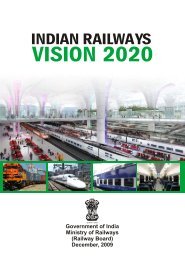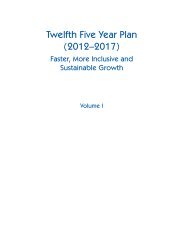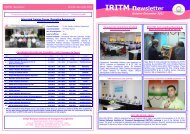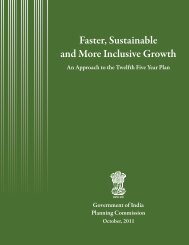Approach 12 FYP - Indian Railways Institute of Transport Management
Approach 12 FYP - Indian Railways Institute of Transport Management
Approach 12 FYP - Indian Railways Institute of Transport Management
Create successful ePaper yourself
Turn your PDF publications into a flip-book with our unique Google optimized e-Paper software.
6 <strong>Approach</strong> to the Twelfth Five Year Plan<br />
Employment and Livelihood<br />
1.19 For growth to be inclusive it must create adequate livelihood opportunities and add to decent<br />
employment commensurate with the expectations <strong>of</strong> a growing labour force. As noted above, India’s<br />
young age structure <strong>of</strong>fers a potential demographic dividend for growth, but this potential will be realised<br />
only if the extent and quality <strong>of</strong> education and skill development among new entrants to the workforce<br />
is greatly enhanced. One <strong>of</strong> the most remarkable things brought out by the 66th round National Sample<br />
Survey Organization (NSSO) survey on Employment (2009-10) is that the number <strong>of</strong> young people in<br />
education, and therefore, out <strong>of</strong> the workforce, has increased dramatically causing a drop in the labour<br />
participation rate. 2 The total number <strong>of</strong> young working-age (15-24) people who continued in educational<br />
institutions doubled from about 30 million in 2004-05 to over 60 million in 2009-10.<br />
1.20 The survey also shows that between 2004-05 and 2009-10, the overall labour force expanded by only<br />
11.7 million. This was considerably lower than comparable periods earlier, and can be attributed to the<br />
much larger retention <strong>of</strong> youth in education, and also because <strong>of</strong> lower labour force participation among<br />
working-age women. Over the same period, 18 million job opportunities were created on current daily<br />
status basis. Thus, in absolute terms, unemployment came down by 6.3 million; and the unemployment<br />
rate which had increased from 6.06 per cent in 1993-94 to 7.31 per cent in 1999-2000 and further to 8.28<br />
per cent in 2004-05, came down to 6.60 in 2009-10.<br />
1.21 The lower growth in the labour force is not expected to continue in future and we can assume<br />
that much larger numbers <strong>of</strong> educated youth will be joining the labour force in increasing numbers<br />
during the Twelfth Plan and in the years beyond. The clear implication <strong>of</strong> this is that the pace <strong>of</strong> job/<br />
livelihood creation must be greatly accelerated. Part <strong>of</strong> this must come from a significant boost to the<br />
manufacturing sector <strong>of</strong> the economy, such that it grows at a rate that is faster than most other parts <strong>of</strong> the<br />
economy. However, this may not be enough, in part because not all categories <strong>of</strong> manufacturing are labour<br />
intensive. Although GDP from manufacturing increased at 9.5 per cent per annum between 2004-05 and<br />
2009-10 along with some increase in employment in the organised manufacturing sector, the survey suggests<br />
that overall employment in manufacturing actually declined during this period. The implied shake-out <strong>of</strong><br />
labour from the un-organised manufacturing sector needs to be examined in detail and appropriate steps<br />
taken so that the obvious potential <strong>of</strong> the MSME sector as a source <strong>of</strong> jobs/livelihoods is realised fully.<br />
1.22 The 66th round NSSO Survey <strong>of</strong> Employment shows that the vast majority <strong>of</strong> new jobs created<br />
between 2004-05 and 2009-10 was in casual employment, mainly in construction. While such jobs are<br />
<strong>of</strong>ten more attractive for rural labour than casual work in agriculture, there is a potential for an accelerated<br />
pace <strong>of</strong> creation <strong>of</strong> more durable rural non-farm jobs/livelihood opportunities. Such job opportunities<br />
could come from faster expansion in agro-processing, supply chains and the increased demand for<br />
technical personnel for inputs into various aspects <strong>of</strong> farming that is undergoing steady modernisation,<br />
and also the maintenance <strong>of</strong> equipment and other elements <strong>of</strong> rural infrastructure. The service sector too<br />
has to continue to be a place for creation <strong>of</strong> decent jobs/livelihood opportunities, in both rural and urban<br />
areas.<br />
2<br />
In the age group <strong>of</strong> 5–14 years, 89.3 per cent <strong>of</strong> children were in school in 2009-10, up from 82.4 per cent in 2004-05. Further<br />
this increase was higher for girls, rising from 79.6 per cent in 2004-05 to 87.7 per cent in 2009-10. In the 15–19 years age group,<br />
59.5 per cent <strong>of</strong> young people were in the educational system in 2009-10 as compared to 46.2 per cent in 2004-05. Once again,<br />
the increase was more for girls, from 40.3 to 54.6 per cent. In the next higher age group <strong>of</strong> 20–24 years, 22.5 per cent <strong>of</strong> boys and<br />
<strong>12</strong>.8 per cent <strong>of</strong> girls were still in the educational system in 2009-10 against only 14.9 and 7.6 per cent, respectively, in 2004-05.
















